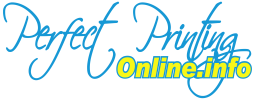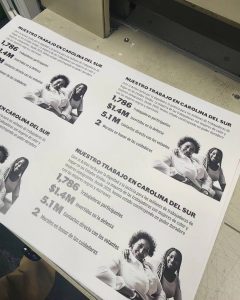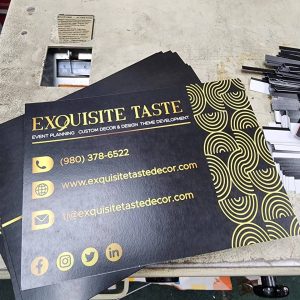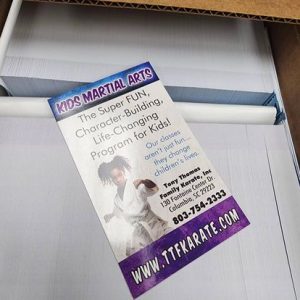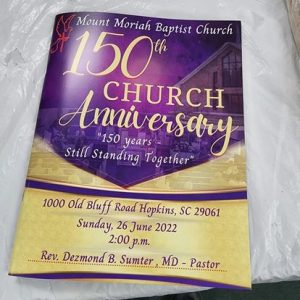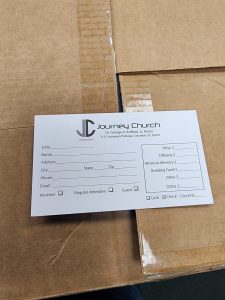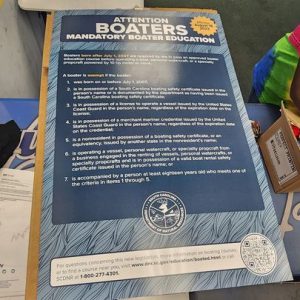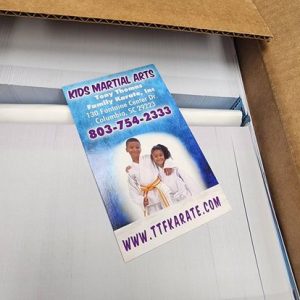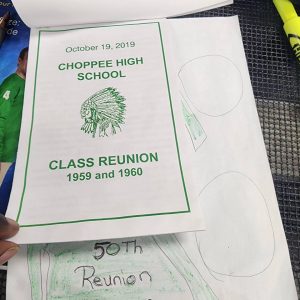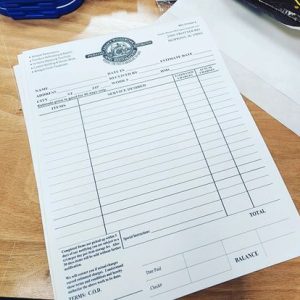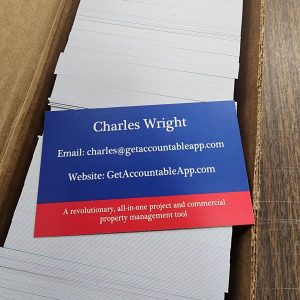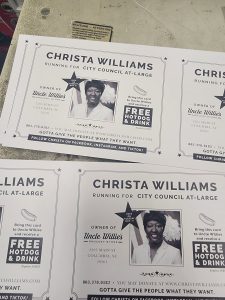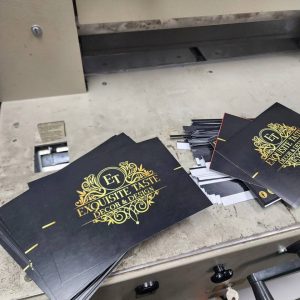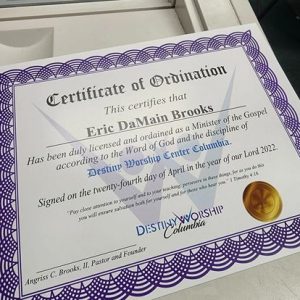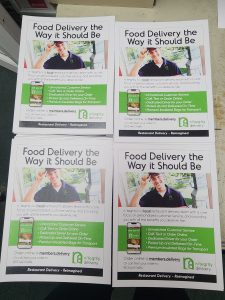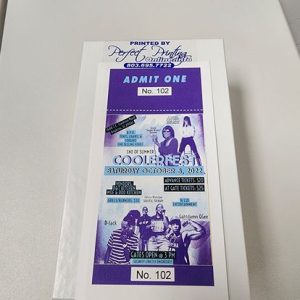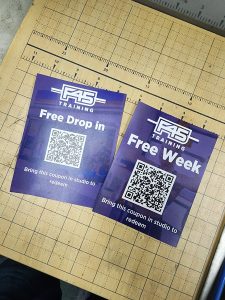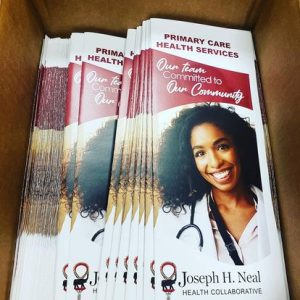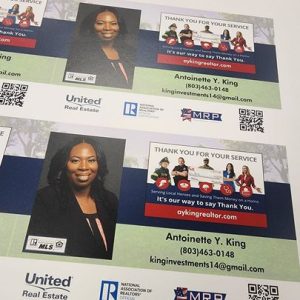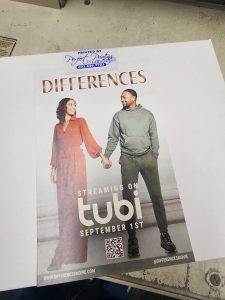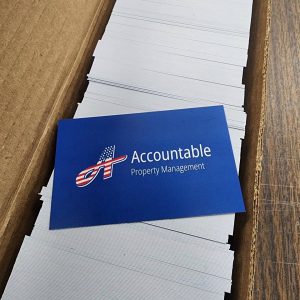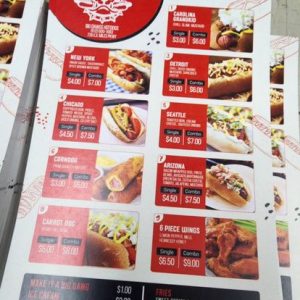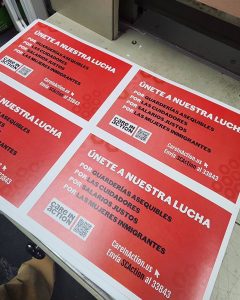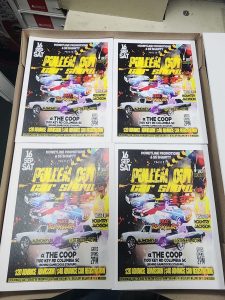FAQ’s
You have questions. We have answers.
How do I go about getting an estimate from you?
Fastest way for a quote is to email our store with very great details pertaining to your project. Please include your artwork, qty, color item and your latest in hand date that you would need the order completed by. If you have an example of your item that you need quoted or have a specific request for an item, please provide that information as well. If we don't respond within 2-3 hours (DURING LOBBY HOURS), we ask that you contact our store 803.695.7722 or shoot us a text at 803.667.1563 to ensure your email didn't go to the spam folder. We ask that you not inbox our social media platforms because that may cause a delay in communication.
How long will it take for you to complete my order?
Every job is different. Some jobs can be produced in 4-6 business days (large volume paper copying / printing / booklet services) while some may take several days to complete (such as screen printing typically is about 14-16 business days). Sign installs could run 14-16 business days or longer depending what material(s) we need to order. Embroidery for small runs could be 4-6 business days and larger runs 10-16 business days. Let us know when you need your job completed and we'll let you know if it can be done. We go to great lengths to meet even your most demanding timelines.
What is the best file format for submitting a document for printing?
The Portable Document Format (PDF) is generally the preferred file format for submitting a document for printing as it works with virtually all professional printing and digital output devices. By design, a PDF file incorporates the information needed to maintain document consistency from system to system. Most other file formats such as Adobe InDesign, Illustrator and Microsoft Word are easily converted to PDF format. All logo and images must be in VECTOR format or there will be an additional fee.
How well will what I see on my monitor match what I see on paper?
The technology of design, layout and printing has come a long way to the point where much of the work is done in a WSYWIG (What You See Is What You Get) digital environment. However, there are sometimes noticeable differences in color calibration and spatial conformity from monitor to monitor and consequently from screen to print.
The process for minimizing any variance begins with adjusting your monitor for optimal color and clarity according to the manufacturer's recommendations as outlined within its product manual or website. Doing this will alleviate a number of potential issues.
Beyond that, for the greatest conformity in color from screen to print, there are tools available that will ensure exact color calibration. Perhaps you have already invested in such a tool. If so, let us know what you use and we'll work with you to achieve the best results. If you are considering investing in a color calibration tool, talk to us first and we'll be happy to offer our advice. If you need a color to match as close as possible we ask that you provide the PMS color code(s).
The process for minimizing any variance begins with adjusting your monitor for optimal color and clarity according to the manufacturer's recommendations as outlined within its product manual or website. Doing this will alleviate a number of potential issues.
Beyond that, for the greatest conformity in color from screen to print, there are tools available that will ensure exact color calibration. Perhaps you have already invested in such a tool. If so, let us know what you use and we'll work with you to achieve the best results. If you are considering investing in a color calibration tool, talk to us first and we'll be happy to offer our advice. If you need a color to match as close as possible we ask that you provide the PMS color code(s).
What is a proof and why is it needed?
A proof is a one-off copy of your printed document used for visual inspection to ensure that the layout and colors of your document are exactly how they are intended to be. A proof is made prior to sending the document to the press for final printing.
Typically, we will produce a proof that will be sent to you online in PDF / JPEG format or on printed paper, which can be either viewed in our store or delivered to you via email.
Your approval on the final proof is the best assurance you have that every aspect of our work and your own is correct, and that everything reads and appears the way you intended. Mistakes can and sometimes do happen. It benefits everyone if errors are caught in the proofing process rather than after the job is completed and delivered. We do not offer refunds or reprints after an approval has been given. Please ask questions upfront before approving your project.
Typically, we will produce a proof that will be sent to you online in PDF / JPEG format or on printed paper, which can be either viewed in our store or delivered to you via email.
Your approval on the final proof is the best assurance you have that every aspect of our work and your own is correct, and that everything reads and appears the way you intended. Mistakes can and sometimes do happen. It benefits everyone if errors are caught in the proofing process rather than after the job is completed and delivered. We do not offer refunds or reprints after an approval has been given. Please ask questions upfront before approving your project.
What are the different grades of paper and their respective basis weight?
The basis weight of a given grade of paper is defined as the weight (in pounds) of 500 standard-sized sheets of that paper. With that in mind, here are different examples of paper grades and their respective basis weights:
Bond: Most commonly used for letterhead, business forms and copying. Typical basis weights are16# for forms, 20# for copying and 24# for stationery.
Text: A high-quality grade paper with a lot of surface texture. Basis weights range from 60# to 100# with the most common being 70# or 80#.
Uncoated Book: The most common grade for offset printing. Typically 50# to 70#.
Coated Book: Has a glossy finish that yields vivid colors and overall excellent reproduction. Basis weights range from 30# to 70# for web press, and 60# to 110# for sheet press.
Cover: Used in creating business cards, postcards and book covers. Can be either coated or uncoated. Basis weights for this grade are 60#, 65#, 80# or 100#.
Bond: Most commonly used for letterhead, business forms and copying. Typical basis weights are16# for forms, 20# for copying and 24# for stationery.
Text: A high-quality grade paper with a lot of surface texture. Basis weights range from 60# to 100# with the most common being 70# or 80#.
Uncoated Book: The most common grade for offset printing. Typically 50# to 70#.
Coated Book: Has a glossy finish that yields vivid colors and overall excellent reproduction. Basis weights range from 30# to 70# for web press, and 60# to 110# for sheet press.
Cover: Used in creating business cards, postcards and book covers. Can be either coated or uncoated. Basis weights for this grade are 60#, 65#, 80# or 100#.
What is the difference between coated and uncoated paper stock?
Uncoated stock paper is comparatively porous and inexpensive, and is typically used for such applications as newspaper print and basic black-and-white copying. Coated stock, by contrast, is made of higher quality paper having a smooth glossy finish that works well for reproducing sharp text and vivid colors. It tends to be more expensive, however.
What does "camera ready" mean?
In the digital age of printing, it means that an image file submitted for printing is ready to be transferred to the printing plates without any alterations. Your artwork and files must be print ready. We offer very little graphic services but if you need us to setup a file or vector artwork, that will be available at an additional fee. Cost varies based on each job.
What is color separation?
Color separation is the process of separating a colored graphic or photograph into its primary color components in preparation for printed reproduction. For example, to print a full color photo with an offset printing press, we would create four separate printing plates each accounting for one of the four basic printing inks (cyan, magenta, yellow, and black) needed to reproduce the image.
As the paper is fed through the press, each single-color plate puts onto the paper the exact amount of ink needed at exactly the right spot. As the different colored wet inks are applied, they blend together to create the rich and infinite pallet of complex colors needed to reproduce the original image.
As the paper is fed through the press, each single-color plate puts onto the paper the exact amount of ink needed at exactly the right spot. As the different colored wet inks are applied, they blend together to create the rich and infinite pallet of complex colors needed to reproduce the original image.
What is halftone printing?
Halftone printing converts a continuous tone (solid areas of black or color) photograph or image into a pattern of different size dots that simulate continuous tone. When examining the page closely, you will see a series of dots spaced slightly apart. At a normal viewing distance, however, the spacing between dots becomes essentially invisible to the eye and what you see is a continuous tone.
What are Pantone colors?
Pantone colors refer to the Pantone Matching System (PMS), a color matching system used by the printing industry whereby printing colors are identified by a unique name or number (as opposed to just a visual reference). This helps make sure that colors turn out the same from system to system, and print run to print run.
Is white considered a printing color?
When it comes to screen printing, YES. When it comes to paper printing, NO. White is not generally considered a printing color as typically the paper itself will be white. If a colored paper (something other than white) is chosen, then white becomes a printing color if any text or graphics require it.
What are the most common sizes for catalogs and booklets?
Standard sizes for catalogs and booklets are 5 1/2" x 8 1/2", 8 1/2" x 11", 8 1/2" x 11 and 11" x 17".
What are the most common sizes for brochures?
Common brochure sizes are 8 1/2" x 11", 8 1/2" x 14" and 11" x 17".
What are the most common business envelope sizes?
Business envelope sizes are referenced by a number such as #9 or #10. The chart below indicates the most common sizes in use today:
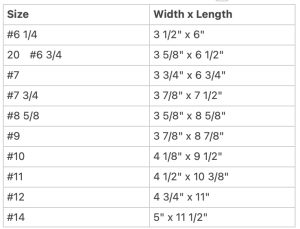
What is the standard size of the address window on a business envelope?
The address window on a typical business envelope measures 4 1/2" x 1 1/8".
What requirements does the USPS have for envelopes?
These are the U.S. Post Office requirements to keep in mind when designing an envelope:
All mail pieces 1/4" thick or less must be rectangular in shape, at least 3 1/4" high and at least 5" long.
Any mail piece less than 4 1/4" in height must be at least .007" (7 pt.) thick.
Any mail piece greater than 4 1/4" in height or 6" in length must be at least .009" (9 pt.) thick.
Any mail piece less than 4 1/4" in height must be at least .007" (7 pt.) thick.
Any mail piece greater than 4 1/4" in height or 6" in length must be at least .009" (9 pt.) thick.
What are the standard sizes for postcards?
Postcards are found in three common sizes: 4" x 6", 5" x 7" and 5 1/2" x 8 1/2". If you put 4up on a 8.5x11 document, that size is 4.25" x 5.5".
What are the most common card stocks used for postcards?
The most common card stocks used for postcards are:
100# stock coated on both sides: The most popular postcard stock.
100# stock coated on one side: Well suited to mailing.
12 pt stock coated on both sides: a premium paper with a high luster finish.
100# stock coated on both sides: The most popular postcard stock.
100# stock coated on one side: Well suited to mailing.
12 pt stock coated on both sides: a premium paper with a high luster finish.
What are the types of bindings I can use for multi-page projects?
Some of the common methods of binding books and other multi-page documents include:
Perfect binding: Gluing the outside edges of the pages together to create a flat edge.
Saddle-stitch binding: Using staples along the folds of the pages to bind them together.
Spiral binding: Wires in a spiral form threaded through punched holes along the binding edge of the papers. Allows the document to lay open flatly.
Plastic comb binding: Similar to spiral binding but using a tubular plastic piece with teeth that fit through rectangular holes punched into the binding edge.
Three-ring binding: Holes are punched into the pages and fitted into a binder.
Perfect binding: Gluing the outside edges of the pages together to create a flat edge.
Saddle-stitch binding: Using staples along the folds of the pages to bind them together.
Spiral binding: Wires in a spiral form threaded through punched holes along the binding edge of the papers. Allows the document to lay open flatly.
Plastic comb binding: Similar to spiral binding but using a tubular plastic piece with teeth that fit through rectangular holes punched into the binding edge.
Three-ring binding: Holes are punched into the pages and fitted into a binder.
Are there price breaks for ordering larger quantities of documents?
We do offer price breaks on higher volume jobs. Please call us at (803) 695-7722 to speak to our sales team.
At what resolution should I save my photos and graphics?
Picture resolution should be set to 300 dpi at the final use size.
Pictures and graphics pulled from the internet are often low resolution, typically 72 dpi. You should avoid using these low resolution graphics, as they will appear pixelated and blocky when printed.
Also note that you should save all photos in CMYK mode, not RGB mode when possible. Images saved in RGB mode may not print properly. If you are unable to save your image in CYMK mode, please contact us for assistance.
Pictures and graphics pulled from the internet are often low resolution, typically 72 dpi. You should avoid using these low resolution graphics, as they will appear pixelated and blocky when printed.
Also note that you should save all photos in CMYK mode, not RGB mode when possible. Images saved in RGB mode may not print properly. If you are unable to save your image in CYMK mode, please contact us for assistance.
What's your minimum for screen printing?
Our minimum for printing shirts is 12 pieces
How do people pay?
Once we come up with a price and you’re ready to go, we will send you an invoice via email that you can pay securely online with a credit card. If you don’t want to pay online, you can call in your credit card information (paying online is usually easiest for everyone.)
We can also take PayPal, Cash App, company check, although waiting for a check to come and clear will delay the order. Money order by mail would work too! Note that we require payment before starting, so that makes working with Purchase Orders difficult but we do accept them if your entity is approved prior by management. We waive the right to not accept a Purchase Order. We also accept Zelle.
We can also take PayPal, Cash App, company check, although waiting for a check to come and clear will delay the order. Money order by mail would work too! Note that we require payment before starting, so that makes working with Purchase Orders difficult but we do accept them if your entity is approved prior by management. We waive the right to not accept a Purchase Order. We also accept Zelle.
Can I submit my own shirts?
Maybe, and we will need to know all the details before we can agree to print them, to make sure they are of a quality and type that we can use.
We prefer to provide the shirts and hoodies, and with the amount of blank items that we buy annually, we get just about the best pricing possible, so it’s better economically for us to provide the blanks. Also please note we don't replace or refund customer provided garments if something gets damaged during the printing process. It's unfortunate but many shops do not allow clients to bring in their own items for this reason. We allow this service as a courtesy.
We prefer to provide the shirts and hoodies, and with the amount of blank items that we buy annually, we get just about the best pricing possible, so it’s better economically for us to provide the blanks. Also please note we don't replace or refund customer provided garments if something gets damaged during the printing process. It's unfortunate but many shops do not allow clients to bring in their own items for this reason. We allow this service as a courtesy.
Can you burn a screen for me?
No, sorry, that is not a service we offer.
Can you save a screen for me?
No, sorry, that is not a service we offer. However, we do save your artwork but we have to burn screens and set up the press all over again.
Why don't you show pricing on the site?
Because pricing is so complicated. It's based on what kind of garment, how many colors and locations to print, and the quantity printed at a time.
It doesn't take long to come up with a quote for your project, so just email us at perfectprintingonline@gmail.com, or call us at 1-803-695-7722 for a quote!
It doesn't take long to come up with a quote for your project, so just email us at perfectprintingonline@gmail.com, or call us at 1-803-695-7722 for a quote!
What if I don't even have artwork or have a concept but not a file to send?
No problem! Tell us your ideas and we can create it for you. But we only offer a 1 time proof based on what we've discussed. The proof is to review spelling / punctuation errors. We unfortunately are not a design firm and don't send multiple revisions for clients who feel they want to "tweak" the design. We focus on production daily and revisions slow us down as a team. If you are a person who needs multiple changes, need to be hands on with the design process, or a very picky client....we ask that you find a designer or design firm and provide your design concept. If it's not print ready or vector, we do charge a fee for that.
How do I cancel my order?
We have a non-refundable policy. If approved management may offer a cancellation fee but it's at management's discretion.
What materials are your banners made from?
Vinyl Banners are printed on 13-oz. scrim vinyl gloss, 13-oz. Scrim vinyl matte, 18-oz. Heavy-duty matte vinyl as well as mesh, canvas and fabric materials.
Do your banners come with grommets?
Yes. Our standard finishing option is heat welded hems with grommets. Brass, stainless steel or plastic grommets are placed in all four corners and every 2-4 feet around the banner perimeter.
(*Express fee available at an
additional charge.)
Our graphic department will be glad to vector your artwork by making it PRINT READY (at an additional fee).
Call the office at
(803) 695-7222
——–
Call or Text us at (803) 667-1563
——–
email: perfectprintingonline@gmail.com
——–
Call or Text us at (803) 667-1563
——–
email: perfectprintingonline@gmail.com
